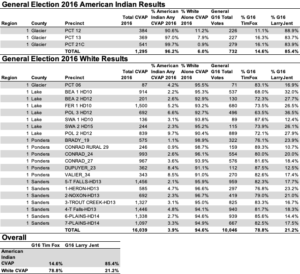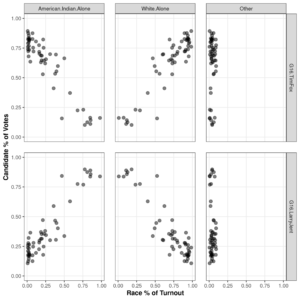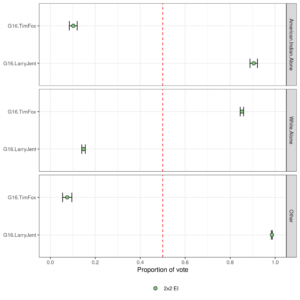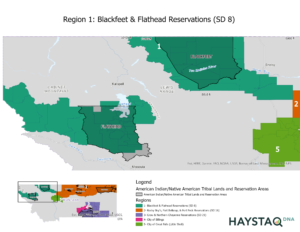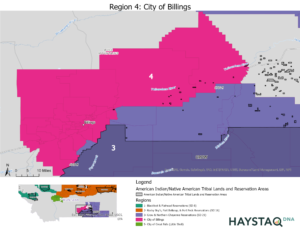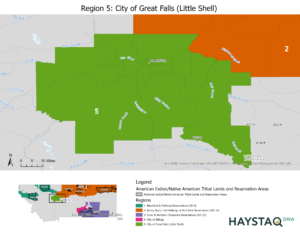Expanding Democrat’s Holdings in State Legislatures by Leveraging Abortion
Download a PDF of this Report
This white paper takes advantage of Haystaq’s national issue scores to identify expansion targets for the Democratic Party in state legislative elections.[1] Based on feedback we have received, we focused on the following chambers in bold that we believe are pick up opportunities when using abortion related messaging. This analysis considers all seats being contested by the two major parties, excluding only those rated as “Solid D” by CNalysis (whose seat ratings this paper adopts).
|
Expansion Targets 2022[2] |
Protects 2022 Cycle |
Long-term Opportunities |
|
Michigan House |
Nevada House, and Senate |
Georgia House only |
|
Pennsylvania House |
Maine Senate |
North Carolina House |
|
Arizona Senate |
Minnesota House |
North Carolina Senate |
|
Michigan Senate |
The table below briefly summarizes the legal status of abortion in the targeted states and public option in the state overall. It is quite possible that abortion may prove to be a more salient issue in states where the current abortion policy is at odds with the opinion of the majority of voters.
|
State |
Legal |
Constitutional Protection |
Legislative Control |
% supporting Abortion Statewide |
Abortion Rights Under Threat |
|
Arizona |
No (pending court challenges) |
No |
GOP |
56% |
Yes |
|
Pennsylvania |
Yes |
No |
GOP |
56% |
Yes[3] |
|
Minnesota |
Yes |
Yes (non-explicit) |
Split |
54% |
No |
|
Michigan |
Yes (pending court action) |
No |
GOP |
55% |
No |
|
Nevada |
Yes |
Yes |
Dem |
63% |
No |
|
Maine |
Yes |
No |
Dem |
62% |
No |
|
North Carolina |
Yes (viability) |
No |
GOP |
49% |
Yes |
|
Georgia |
Yes (6-weeks) |
No |
GOP |
49% |
Yes |
|
Texas |
No |
No |
GOP |
46% |
Yes |
The key finding is, given that the vast majority of Americans disapprove of the overturning of Roe versus Wade, there are several dozen GOP held state legislative seats with pro-choice majorities and where Haystaq’s data can be used to id and target pro-choice voters, and there are many more seats where vulnerable Democrats can use the abortion issue to bolster their electoral position. If Democrats succeed in unifying the pro-choice vote, the party could gain control over both houses of the Michigan legislature along with the Pennsylvania House and the Arizona Senate. Of these legislative chambers, the Michigan Senate will be the easiest to flip, followed by the PA House and AZ Senate.[4] Evidence from field testing and from recent special elections shows that this issue indeed moves vote choice.
The tables below highlight seats in each legislative chamber where abortion related messaging can make a difference with expansion opportunity seats in bold and districts ranked by the salience of the abortion issue. The race ratings key below is taken from CNalysis. For each chamber, the number of seats currently held by the GOP which have Pro Choice majorities is noted, and the information is underlined when the number of seats is enough to flip control of the chamber to the Democrats.
|
Race Ratings Key |
|
Solid R |
|
Very Likely R |
|
Likely R |
|
Lean R |
|
Tilt R |
|
Tossup |
|
Tilt D |
|
Lean D |
|
Likely D |
|
Very Likely D |
Expansion Targets
MI Senate (Chamber Rating: toss-up)
- 3 flips possible
- 3 seats need for control
|
District With CN Analysis Rating |
Current Hold |
Reg Voters |
Likely Voters |
Count Pro Choice |
Count Pro Choice Likely Voters |
Percent Pro Choice |
|
13 |
D |
203,108 |
96,391 |
124,993 |
59,925 |
62.2% |
|
21 |
R |
198,356 |
72,090 |
124,412 |
42,377 |
58.8% |
|
4 |
D |
209,569 |
71,730 |
121,671 |
41,947 |
58.5% |
|
14 |
R |
201,075 |
82,691 |
109,008 |
47,801 |
57.8% |
|
28 |
R |
181,207 |
74,818 |
104,858 |
42,582 |
56.9% |
|
9 |
D |
185,843 |
75,889 |
102,357 |
40,839 |
53.8% |
|
11 |
D |
198,566 |
64,910 |
108,308 |
33,591 |
51.8% |
PA House (Chamber Rating likely R)
- 15 flips identified
- 12 seats needed for control
|
District With CN Analysis Rating |
Current Hold |
Reg Voters |
Likely Voters |
Count Pro Choice |
Count Pro Choice Likely Voters |
Percent Pro Choice |
|
172 |
D |
33,927 |
10,996 |
22,451 |
7,861 |
71.5% |
|
45 |
D |
43,874 |
15,931 |
27,537 |
10,751 |
67.5% |
|
121 |
D |
31,109 |
9,160 |
19,974 |
6,054 |
66.1% |
|
25 |
D |
42,922 |
15,281 |
25,405 |
9,733 |
63.7% |
|
16 |
D |
40,813 |
14,148 |
21,510 |
8,880 |
62.8% |
|
118 |
D |
42,605 |
17,678 |
23,913 |
11,075 |
62.6% |
|
33 |
R |
42,033 |
17,389 |
22,957 |
10,729 |
61.7% |
|
2 |
D |
40,142 |
15,108 |
22,620 |
9,219 |
61.0% |
|
151 |
R |
45,408 |
20,190 |
25,941 |
12,161 |
60.2% |
|
61 |
D |
45,892 |
22,495 |
25,552 |
12,769 |
56.8% |
|
29 |
R |
49,874 |
24,003 |
26,528 |
13,555 |
56.5% |
|
137 |
R |
44,561 |
15,873 |
23,385 |
8,956 |
56.4% |
|
189 |
R |
37,397 |
8,393 |
20,618 |
4,691 |
55.9% |
|
53 |
D |
40,307 |
14,872 |
22,866 |
8,240 |
55.4% |
|
115 |
D |
37,081 |
8,163 |
20,666 |
4,517 |
55.3% |
|
39 |
R |
44,855 |
17,716 |
21,461 |
9,763 |
55.1% |
|
146 |
D |
41,054 |
12,209 |
22,100 |
6,662 |
54.6% |
|
30 |
R |
44,426 |
20,948 |
22,894 |
11,429 |
54.6% |
|
168 |
R |
42,387 |
19,484 |
22,816 |
10,466 |
53.7% |
|
3 |
D |
44,772 |
19,822 |
22,179 |
10,629 |
53.6% |
|
26 |
R |
42,572 |
16,872 |
22,166 |
9,037 |
53.6% |
|
142 |
R |
43,865 |
17,959 |
22,188 |
9,544 |
53.1% |
|
18 |
R |
39,719 |
12,975 |
22,449 |
6,835 |
52.7% |
|
51 |
R |
38,160 |
12,060 |
16,212 |
6,323 |
52.4% |
|
144 |
R |
45,006 |
18,380 |
22,831 |
9,625 |
52.4% |
|
74 |
D |
37,401 |
10,581 |
18,538 |
5,449 |
51.5% |
|
82 |
R |
37,986 |
13,096 |
20,020 |
6,678 |
51.0% |
|
120 |
R |
39,922 |
15,036 |
18,435 |
7,586 |
50.5% |
AZ Senate (Chamber Rating: Very Likely R)
- 3 flips possible
- 2 seats needed for control
|
District With CN Analysis Rating |
Current Hold |
Reg Voters |
Likely Voters |
Count Pro Choice |
Count Pro Choice Likely Voters |
Percent Pro Choice |
|
11 |
R |
112,243 |
21,923 |
79,713 |
16,064 |
73.3% |
|
18 |
D |
158,642 |
75,347 |
111,147 |
48,576 |
64.5% |
|
8 |
R |
128,059 |
36,355 |
87,767 |
21,919 |
60.3% |
|
23 |
R |
120,100 |
24,701 |
68,004 |
12,805 |
51.8% |
MI House (Chamber Rating: lean R)
- 8 flips possible
- 3 seats needed to gain control
bgcolor=”blue”
|
District With CN Analysis Rating |
Current Hold |
Reg Voters |
Likely Voters |
Count Pro Choice |
Count Pro Choice Likely Voters |
Percent Pro Choice |
|
20 |
D |
74,703 |
33,317 |
44,633 |
21,164 |
63.5% |
|
2 |
D |
65,447 |
18,182 |
40,242 |
10,875 |
59.8% |
|
21 |
D |
58,957 |
28,645 |
36,086 |
16,881 |
58.9% |
|
40 |
D |
67,752 |
30,234 |
41,519 |
17,688 |
58.5% |
|
69 |
D |
72,560 |
22,945 |
41,253 |
13,418 |
58.5% |
|
22 |
D |
74,522 |
38,574 |
42,596 |
21,876 |
56.7% |
|
73 |
R |
55,292 |
23,075 |
31,876 |
13,015 |
56.4% |
|
80 |
R |
66,445 |
27,813 |
38,367 |
15,675 |
56.4% |
|
81 |
R |
68,707 |
30,413 |
38,364 |
16,737 |
55.0% |
|
27 |
D |
71,170 |
27,671 |
38,741 |
15,117 |
54.6% |
|
31 |
D |
72,470 |
25,464 |
38,074 |
13,908 |
54.6% |
|
55 |
D |
66,620 |
31,869 |
38,131 |
17,284 |
54.2% |
|
28 |
D |
69,534 |
22,056 |
36,538 |
11,800 |
53.5% |
|
83 |
R |
59,140 |
14,944 |
36,566 |
7,973 |
53.4% |
|
54 |
D |
69,211 |
32,757 |
40,086 |
17,424 |
53.2% |
|
84 |
R |
66,713 |
23,496 |
38,486 |
12,497 |
53.2% |
|
57 |
R |
63,492 |
19,714 |
31,956 |
10,376 |
52.6% |
|
58 |
R |
65,522 |
21,407 |
34,247 |
11,175 |
52.2% |
|
48 |
R |
73,170 |
35,774 |
36,904 |
18,598 |
52.0% |
|
61 |
D |
71,308 |
24,653 |
38,596 |
12,660 |
51.4% |
|
76 |
D |
70,433 |
29,252 |
37,021 |
14,962 |
51.1% |
|
68 |
D |
73,016 |
26,474 |
39,197 |
13,513 |
51.0% |
Protects
NV House (Chamber Rating: Lean D)
- 1 flip possible
|
District With CN Analysis Rating |
Current Hold |
Reg Voters |
Likely Voters |
Count Pro Choice |
Count Pro Choice Likely Voters |
Percent Pro Choice |
|
42 |
D |
44,553 |
12,768 |
25,434 |
7,464 |
58.5% |
|
8 |
D |
45,109 |
11,885 |
24,845 |
6,932 |
58.3% |
|
1 |
D |
51,497 |
17,487 |
28,641 |
10,081 |
57.6% |
|
16 |
D |
44,548 |
11,222 |
26,180 |
6,403 |
57.1% |
|
9 |
D |
45,980 |
14,436 |
24,380 |
7,992 |
55.4% |
|
34 |
D |
46,428 |
14,224 |
26,023 |
7,855 |
55.2% |
|
41 |
D |
49,126 |
15,291 |
26,150 |
8,440 |
55.2% |
|
35 |
D |
49,196 |
15,937 |
25,225 |
8,609 |
54.0% |
|
5 |
D |
46,656 |
15,138 |
25,280 |
8,115 |
53.6% |
|
29 |
D |
47,750 |
15,236 |
25,112 |
8,103 |
53.2% |
|
3 |
D |
43,360 |
12,115 |
24,085 |
6,425 |
53.0% |
|
25 |
R |
49,102 |
25,773 |
25,767 |
13,467 |
52.3% |
|
21 |
D |
49,808 |
18,523 |
25,623 |
9,670 |
52.2% |
|
12 |
D |
43,998 |
13,569 |
24,805 |
6,950 |
51.2% |
NV Senate (Chamber Rating: Very Likely D)
- 0 flips possible
- None of the districts up for election this cycle have a majority of voters that are pro-choice, the below districts are analyzed based on registered rather than likely voters
|
District With CN Analysis Rating |
Current Hold |
Reg Voters |
Count Pro Choice |
Percent Pro Choice |
|
8 |
D |
96,819 |
48,480 |
50% |
|
9 |
D |
90,550 |
49,824 |
55% |
|
12 |
R |
98,969 |
51,790 |
52.3% |
ME Senate (Chamber Rating: Toss-Up)
- 0 flips possible
- GOP needs nine seats to gain control
|
District With CN Analysis Rating |
Current Hold |
Reg Voters |
Likely Voters |
Count Pro Choice |
Count Pro Choice Likely Voters |
Percent Pro Choice |
|
21 |
D |
25,931 |
7,124 |
17,802 |
4,036 |
56.7% |
|
32 |
D |
26,344 |
8,889 |
14,976 |
4,884 |
54.9% |
|
31 |
D |
28,733 |
9,933 |
15,916 |
5,400 |
54.4% |
|
34 |
D |
31,246 |
12,996 |
15,178 |
6,576 |
50.6% |
MN House (Tilt R)
- 0 flips possible
- GOP needs four seats to gain control
|
District With CN Analysis Rating |
Current Hold |
Reg Voters |
Likely Voters |
Count Pro Choice |
Count Pro Choice Likely Voters |
Percent Pro Choice |
|
53B |
D |
25,309 |
7,593 |
16,415 |
4,114 |
54.2% |
Long Term Opportunities
NC House (Chamber Rating: Very Likely R)
- 8 flips possible
- 18 seats needed for control
|
District With CN Analysis Rating |
Current Hold |
Reg Voters |
Likely Voters |
Count Pro Choice |
Count Pro Choice Likely Voters |
Percent Pro Choice |
|
50 |
D |
59,865 |
27,811 |
38,018 |
19,911 |
71.6% |
|
54 |
D |
61,270 |
30,619 |
38,775 |
21,297 |
69.6% |
|
36 |
D |
61,463 |
25,334 |
39,993 |
17,206 |
67.9% |
|
40 |
D |
65,822 |
31,750 |
41,228 |
20,272 |
63.8% |
|
2 |
R |
59,451 |
25,007 |
34,722 |
15,938 |
63.7% |
|
115 |
D |
60,045 |
24,852 |
35,735 |
15,817 |
63.6% |
|
47 |
D |
47,726 |
11,876 |
25,628 |
7,539 |
63.5% |
|
35 |
D |
60,762 |
24,066 |
37,173 |
15,226 |
63.3% |
|
48 |
D |
48,841 |
13,585 |
28,474 |
8,535 |
62.8% |
|
45 |
R |
47,078 |
12,215 |
28,417 |
7,652 |
62.6% |
|
105 |
D |
56,324 |
20,484 |
35,701 |
12,659 |
61.8% |
|
98 |
R |
60,543 |
22,631 |
34,947 |
13,450 |
59.4% |
|
104 |
D |
59,160 |
27,187 |
35,184 |
16,127 |
59.3% |
|
9 |
D |
55,901 |
19,298 |
32,233 |
11,185 |
58.0% |
|
103 |
D |
60,482 |
26,478 |
35,050 |
15,210 |
57.4% |
|
62 |
R |
64,967 |
28,217 |
38,258 |
16,097 |
57.0% |
|
32 |
D |
52,567 |
17,380 |
29,592 |
9,815 |
56.5% |
|
37 |
R |
61,579 |
23,314 |
33,283 |
12,959 |
55.6% |
|
73 |
R |
51,777 |
17,394 |
27,506 |
9,460 |
54.4% |
|
43 |
R |
52,756 |
16,831 |
27,273 |
8,767 |
52.1% |
|
74 |
R |
62,114 |
26,190 |
32,873 |
13,619 |
52.0% |
|
20 |
R |
62,597 |
24,229 |
30,376 |
12,350 |
51.0% |
|
24 |
D |
54,889 |
18,154 |
28,798 |
9,097 |
50.1% |
NC Senate (Chamber Rating: Very Likely R)
- 2 flips possible
- 4 seats need for control
|
District With CN Analysis Rating |
Current Hold |
Reg Voters |
Likely Voters |
Count Pro Choice |
Count Pro Choice Likely Voters |
Percent Pro Choice |
|
17 |
D |
136,972 |
53,338 |
81,240 |
32,867 |
61.6% |
|
24 |
R |
115,536 |
30,281 |
63,238 |
18,564 |
61.3% |
|
18 |
D |
135,437 |
53,694 |
79,153 |
32,830 |
61.1% |
|
19 |
D |
128,229 |
37,142 |
76,536 |
22,350 |
60.2% |
|
42 |
R |
143,920 |
59,588 |
87,923 |
35,736 |
60.0% |
|
3 |
D |
136,151 |
47,483 |
69,517 |
24,703 |
52.0% |
GA House (Chamber Rating: Very Likely R)
- 1 flip possible
- 14 seats needed for control
|
District With CN Analysis Rating |
Current Hold |
Reg Voters |
Likely Voters |
Count Pro Choice |
Count Pro Choice Likely Voters |
Percent Pro Choice |
|
54 |
D |
38,541 |
14,555 |
28,391 |
9,010 |
61.9% |
|
106 |
D |
39,923 |
15,464 |
22,184 |
8,580 |
55.5% |
|
50 |
D |
36,503 |
13,086 |
23,946 |
7,105 |
54.3% |
|
101 |
D |
38,378 |
12,387 |
21,243 |
6,550 |
52.9% |
|
35 |
R |
37,535 |
11,982 |
19,972 |
6,280 |
52.4% |
|
154 |
D |
40,566 |
14,684 |
25,057 |
7,670 |
52.2% |
|
105 |
D |
38,221 |
12,695 |
20,704 |
6,582 |
51.8% |
TX House (Chamber Rating: Very Likely R)
- 2 flips possible
- 10 seats needed for control
|
District With CN Analysis Rating |
Current Hold |
Reg Voters |
Likely Voters |
Count Pro Choice |
Count Pro Choice Likely Voters |
Percent Pro Choice |
|
35 |
D |
72,311.00 |
12,898.00 |
62,774.00 |
10,016.00 |
77.7% |
|
41 |
D |
97,046.00 |
24,425.00 |
81,649.00 |
17,763.00 |
72.7% |
|
74 |
D |
109,198.00 |
25,412.00 |
87,426.00 |
17,676.00 |
69.6% |
|
47 |
D |
129,733.00 |
70,610.00 |
83,307.00 |
43,880.00 |
62.1% |
|
135 |
D |
99,870.00 |
25,133.00 |
66,184.00 |
15,587.00 |
62.0% |
|
37 |
D |
96,832.00 |
23,604.00 |
75,297.00 |
14,532.00 |
61.6% |
|
148 |
D |
89,635.00 |
22,825.00 |
59,411.00 |
13,594.00 |
59.6% |
|
45 |
D |
121,123.00 |
43,602.00 |
74,356.00 |
24,199.00 |
55.5% |
|
105 |
D |
75,258.00 |
20,157.00 |
50,794.00 |
11,005.00 |
54.6% |
|
34 |
D |
103,130.00 |
24,252.00 |
46,370.00 |
12,661.00 |
52.2% |
|
118 |
R |
113,023.00 |
29,691.00 |
70,522.00 |
15,032.00 |
50.6% |
|
31 |
R |
111,130.00 |
35,801.00 |
71,456.00 |
18,112.00 |
50.6% |
Works Cited
“Abortion in Nevada.” Wikipedia, 3 Aug. 2022, en.wikipedia.org/wiki/Abortion_in_Nevada#History. Accessed 9 Aug. 2022.
“Arizona Senate.” Wikipedia, 25 July 2022, en.wikipedia.org/wiki/Arizona_Senate. Accessed 9 Aug. 2022.
“Arizona State Legislative.” Projects.cnalysis.com, projects.cnalysis.com/21-22/state-legislative/arizona. Accessed 9 Aug. 2022.
Center for Reproductive Rights. “Abortion Laws by State.” Center for Reproductive Rights, reproductiverights.org/maps/abortion-laws-by-state/.
Cohn, Nate. “Do Americans Support Abortion Rights? Depends on the State.” The New York Times, 4 May 2022, www.nytimes.com/2022/05/04/upshot/polling-abortion-states.html.
“Georgia House of Representatives.” Wikipedia, 16 June 2022, en.wikipedia.org/wiki/Georgia_House_of_Representatives. Accessed 16 Aug. 2022.
“Maine State Legislative.” Projects.cnalysis.com, projects.cnalysis.com/21-22/state-legislative/maine. Accessed 9 Aug. 2022.
“Michigan Senate.” Wikipedia, 18 May 2022, en.wikipedia.org/wiki/Michigan_Senate. Accessed 9 Aug. 2022.
“Minnesota House of Representatives.” Wikipedia, 24 Mar. 2022, en.wikipedia.org/wiki/Minnesota_House_of_Representatives. Accessed 9 Aug. 2022.
“Minnesota State Legislative.” Projects.cnalysis.com, projects.cnalysis.com/21-22/state-legislative/minnesota. Accessed 9 Aug. 2022.
“Nevada Assembly.” Wikipedia, 7 June 2021, en.wikipedia.org/wiki/Nevada_Assembly.
“Nevada State Legislative.” Projects.cnalysis.com, projects.cnalysis.com/21-22/state-legislative/nevada. Accessed 9 Aug. 2022.
“North Carolina House of Representatives.” Wikipedia, 1 Aug. 2022, en.wikipedia.org/wiki/North_Carolina_House_of_Representatives. Accessed 16 Aug. 2022.
“North Carolina Senate.” Wikipedia, 8 Oct. 2020, en.wikipedia.org/wiki/North_Carolina_Senate.
“North Carolina State Legislative.” Projects.cnalysis.com, projects.cnalysis.com/21-22/state-legislative/north-carolina. Accessed 16 Aug. 2022.
“Pennsylvania House of Representatives.” Wikipedia, 30 July 2022, en.wikipedia.org/wiki/Pennsylvania_House_of_Representatives. Accessed 9 Aug. 2022.
“Pennsylvania State Legislative.” Projects.cnalysis.com, projects.cnalysis.com/21-22/state-legislative/pennsylvania. Accessed 9 Aug. 2022.
Wikipedia Contributors. “Michigan House of Representatives.” Wikipedia, Wikimedia Foundation, 31 Oct. 2019, en.wikipedia.org/wiki/Michigan_House_of_Representatives. Accessed 7 Nov. 2019.
—. “Texas House of Representatives.” Wikipedia, Wikimedia Foundation, 25 Nov. 2019, en.wikipedia.org/wiki/Texas_House_of_Representatives.
[1] In Wyoming and Oklahoma Democrats are not contesting enough seats to take control of the legislature. In West Virginia, the Dakotas, Tenensee, Kentucky, Indiana, and Utah not enough Democratic candidates filed to take control of the upper houses of the legislature. In Massachusetts the GOP is not contesting either house of the legislature and in California the GOP is not contesting the state senate.
[2] The AZ house was not analyzed because CNalysis does not rate these races.
[3] Both houses of the PA leg. are controlled by anti-abortion forces and GOP gubernational nominee Doug Mastriano supports a total ban on abortion
[4] The Michigan house will be difficult to flip because the Dems need to play defense in several challenging seats.


